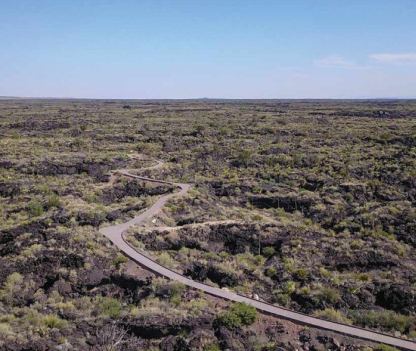Second youngest lava flow in the continental U.S.
November 18, 2023 | Visit Alamogordo
Valley of Fires is one of the youngest lava flows in the continental United States, the second youngest in New Mexico behind the McCartys flow in the El Malpais National Monument. Located 61-miles north of Alamogordo, and four miles west of Carrizozo, the site features an interesting variety of volcanic features, including two types of lava; rough blocks of ‘A’ā (pronounced “ah-ah”) and ropy flows of pahoehoe (pronounced pah-hoh-ey-hoh-ey)], as well as lava caves, pressure ridges, and collapsed gas bubbles.
Explosive Origin Story
Approximately 5,000 years ago, Little Black Peak erupted repeatedly, filling the northern end of the Tularosa Basin with molten rock for approximately 30 years. The lava field is four to six miles wide, 160 feet thick and covers 125 square miles, flowing 44 miles south of the crater into the Tularosa Basin. The lava subsides about 14-miles north of White Sands. The geologic contrast is large enough and striking enough to be seen from space; however, nearby Sierra Blanca provides a more accessible vantage point. Whereas most of the volcanic activity consisted of steady seepage, geologists believe the last eruption, a mere 1,500-2,000 years ago, was more explosive.
Fauna & Flora in the Lava Flow
Valley of Fires is in a transition zone, between the Chihuahuan Desert and grasslands. The undulating, volcanic basalt looks inhospitable, but the harsh environment hosts a surprising abundance of foliage, including cane cholla, juniper, mesquite, creosote, sage and sumac. When the basin gets rain, seeds germinate in every crevice, becoming unusually green for a lava field in the west. The abundance of foliage provides food to numerous furry, feathered, and scaled creatures. In fact, Valley of Fires is a popular destination for birdwatchers, supporting a population of great horned owls, burrowing owls, turkey vultures, hawks, gnat catchers, cactus wrens, sparrows and golden eagles.
The lava field is also home to bats, roadrunners, quail, foxes, cottontails, mule deer, oryx, barberry sheep, snakes, tarantulas, and several varieties of lizard. The snakes are more active from early spring through late fall. If you see one on the trail, let a ranger know, but leave it alone. Usually they leave quickly after encountering a human. Male tarantulas usually embark on their mating march in September through early October. If you see them, let them pass. They have a very narrow window of time to mate before they die.
Malpais Nature Trail
The fully accessible, paved, one-mile loop trail starts at the group shelter, winding into the lava flow. The visitor center has a guide available.
Pets are welcome, but keep in mind that lava is abrasive on exposed paws (and human feet). If you can’t hold your hand to the ground for more than five seconds, it’s far too hot for your dog’s feet!
Boots are a good idea, even more so if you wander off the trail. Watch for snakes and tarantulas. There is no shade. Take a hat and plenty of water.
Day Use
– one person in vehicle, $3
– two or more in vehicle, $5
Camping
The campground is on a ridge of sandstone overlooking the lava fields, with loops adjacent to the lava flows for tent camping.
In total, there are 19 RV sites and 6 tent sites with picnic shelters, tables, grills, and potable water at each site. RV electric hookups are available at 14 sites. Two sites are wheelchair accessible. The full facility bathroom is fully accessible and has a tidy shower area. Vault toilets are available throughout the park. Quiet hours from 10 PM – 7 AM. There are two large day-use shelters available for reservation.
The campsites are exposed to the elements, which means it can be a slow broil during the summer and wind blasted during the spring.
Reserve your campsite through Recreation.gov
Tent Camping – $7
RV Camping
– with water & electric, $18
– without water & electric, $12
– dump Fee – $15
Group Shelter – group use, $25
Tour Bus – 15+ people, $15
Valley of Fires Brochure



